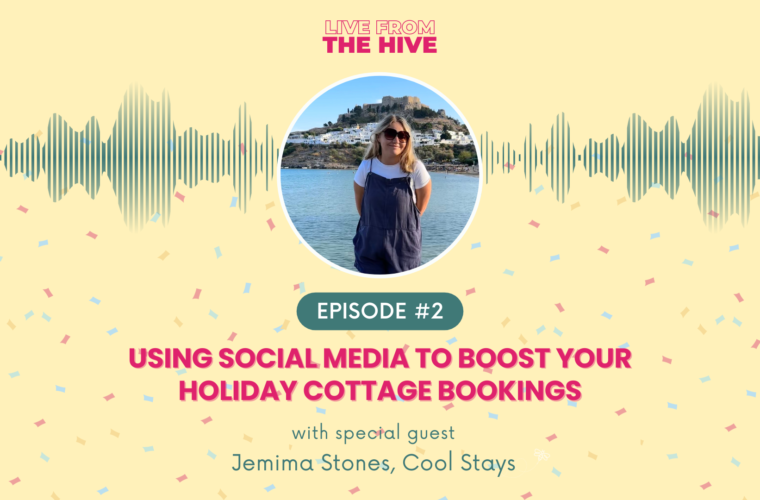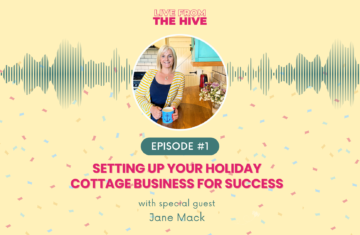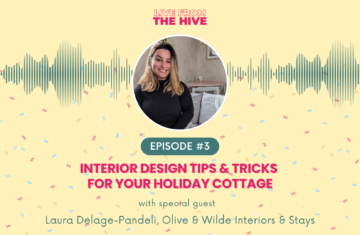So first of all, tell me a little bit about your role at Cool Stays and your experience in the industry and with social media.
Sure! I’ve been with Cool Stays for four years now, having joined at the end of 2020, right after the real staycation boom in the UK. With the lockdowns in place, people couldn’t go abroad or stay in hotels, so self-catering really took off. Cool Stays found themselves in need of a social media and community manager, and I had unfortunately been made redundant during Covid. Prior to that, I was handling social media for a large tourist attraction in Kent, but when it closed for nearly a year, redundancies were inevitable.
So, it worked out perfectly for me to step into my role with Cool Stays. I manage the brand’s social media across all platforms. We’re quite a small team, which often surprises people—there are only 17 employees in total at Cool Stays. On the social media marketing side, there are about four of us. Each of us has unique skills, and we’re quite flexible in our roles, readily jumping in to help each other out with various tasks.
In addition to social media management, I also handle brand collaborations and partnerships, and I’ve organised a couple of events. We’ve even delved into merchandise, which was a fun little experiment! I also engage in graphic design and any other creative tasks the brand requires.
It’s an interesting role because it involves looking after our audience on social media while ensuring that all the property owners we work with at Cool Stays are satisfied with the services we provide. This role is quite different from my previous social media positions. Before joining Cool Stays, I was at Leeds Castle in Kent, managing their social media, so I’ve always been within the tourism and travel sectors. Before that, I worked for a gin distillery that also offered tours, which had a tourism aspect as well. It was a small company, and that experience allowed me to evolve into a more well-rounded marketer.
I studied communications at university, where my focus was heavily on social media, particularly around 2011 when it was just beginning to establish itself as a key entity. Overall, I’ve found a role that perfectly allows me to utilise all my skills and experience, which is absolutely brilliant.
Within marketing, there are so many different areas to specialise in, particularly when it comes to promoting your holiday property. Even within social media, there are numerous ways to engage your audience. How does Cool Stays approach its social media strategy to connect with its target audience?
es, it’s quite a complex role we have to fulfil. We need to ensure that the owners who list with Cool Stays are satisfied with our services. Since we operate on a subscription basis, property owners pay us to be featured on our site. Therefore, it’s essential that we keep them happy. Often, what attracts these owners to us is our substantial social media following and presence.
At the same time, we must ensure that the content we share resonates with our audience. Our overall strategy is to think of social media as a shop window. We aim to showcase the most engaging, scroll-stopping properties, such as a quirky house carved into a boulder or an incredible treehouse in Norway. These unique listings are designed to catch people’s attention and encourage them to visit our site. Even if the specific property they see isn’t what they’re looking for, once they’re on our site, they gain awareness of our brand. This way, when they’re searching for a lovely cottage in the Lake District, they remember us and return.
So, essentially, our social media strategy focuses on building brand recognition while utilising each platform appropriately. For example, we tend to post more regularly on Facebook, where we can include links to promote individual properties effectively. In contrast, we view Instagram as our brand-building platform, which helps cultivate recognition and encourages return visits.
TikTok is still a developing area for us. We’re in the process of identifying the right approach to engage our audience there. However, we’ve managed to grow our following to about 60,000 over the past two years. While TikTok is still attracting a younger demographic—mostly not our target audience—we see that the 25 to 45 age range is growing rapidly on the platform. It’s definitely a space where we need to invest time and establish a presence.
You also utilise Pinterest as a marketing platform. How do you incorporate it into your marketing strategy?
Yes, we do use Pinterest! In the past, we used to post each property individually, but I think they got a bit lost in the feed. Pinterest has shifted significantly, and now it tends to favour having more of a title image as the clickable link. So, we focus on promoting our blog posts more now. For instance, we recently created a post titled “20 Meeting Stays Where You Can Walk to a Pub.” This features a title image that links to the blog, which in turn directs users to a list of properties. It’s a nice gateway into our site.
I believe this approach is more engaging for Pinterest users because they’re often not searching for a specific type of property. Instead, they’re looking for general travel inspiration. So, it’s about tailoring the content we share on each platform to resonate with the respective audiences.
For example, we’ve experimented with YouTube but haven’t seen much success. I think this is due to its larger male audience. Even in 2024, it tends to be women who are making the bookings and conducting research for trips. Our female audience across other platforms is about 80%, which likely explains why YouTube hasn’t gained traction for us in the same way that other platforms have. However, we’re determined to keep working on it.
User-generated content is incredibly important these days for building that “know, like, trust” factor. How does Cool Stays encourage that and engage with followers on social media?
We have a couple of strategies in place for this. First, we use a hashtag, which you can find in our Instagram bio: #CoolStays. This encourages people to share their experiences with us. However, the challenge is that it’s a term that isn’t specific to our brand. If someone describes their stay as “cool,” they might use that hashtag, which leads to a lot of unrelated content that we have to sift through.
To address this, we’ve developed a more targeted approach. Now, after guests book with us, we follow up with an email encouraging them to use the hashtag and tag us in their posts. Each month, we award a voucher—usually around £150 to £200—to the content we find most engaging. This provides an incentive for guests to share their experiences.
Of course, we want guests to focus on enjoying their stay, not worrying about tagging brands. The goal is for them to relax and switch off, especially since many of our cabins are off-grid. We prefer that guests enjoy the moment rather than being glued to their phones. But if they do share content, we love to see it and share it in return.
My colleague manages most of our video content, and she spends quite a bit of time on Instagram searching for reels or posts created by our guests, asking for permission to use them. So, it’s quite an organic process for us when it comes to gathering user-generated content. While we’ve noticed a rise in services offering user-generated content, we haven’t felt the need to engage those just yet.
Have you experimented with influencers or travel bloggers, and how has that impacted your brand visibility?
Yes, we’ve worked with influencers, especially early on. We initially collaborated with travel bloggers like The Travel Project to grow our audience. However, as our audience and property listings expanded, we shifted our focus.
Now, we’re diversifying by collaborating with family-oriented and foodie bloggers to reach new audiences, as many travel followers are already familiar with us. Authentic recommendations from diverse creators can be more impactful than traditional travel content.
We’ve had mixed experiences with influencers, so we now establish clear contracts and agreements to ensure accountability and protect the interests of property owners. This is crucial since hosting creators involves significant responsibility.
Despite the risks, we recognise that influencer marketing is vital for travel promotion. We now track success through unique links provided to influencers, allowing us to measure traffic and bookings effectively, ensuring tangible results for property owners.
What social media trends do you see as most relevant to the industry today?
The most significant trend is the shift from still images to video content. A year ago, we posted maybe one or two videos a week, but now it’s about five reels weekly. We actively encourage property owners to send us video content, reflecting this vital change in the industry.
Another trend is the evolving expectations of travellers. Social media now showcases aspirational and bucket-list experiences, emphasising unique selling points (USPs) for properties, like stunning views or unique features.
Videos must be concise—most reels are now around nine seconds long. We focus on highlighting unique and iconic stays, such as the Bell to Lighthouse or properties featured in popular shows like Sex Education and Bridgerton.
Video content doesn’t need to be lengthy; even short clips can be impactful. While creating content, I remind owners that although I may spend hours filming, the final video will be brief. Ultimately, it’s crucial to align with the algorithm to ensure our content reaches the audience effectively.
How do you measure the success of your social media campaigns?
Our primary goal is to drive traffic to the website. We have a tech team that tracks page views, and it’s rewarding to see our Instagram videos or blog posts leading in visits the following day.
For property owners, traffic metrics can be abstract unless they see inquiries resulting from social media. Therefore, engagement is also crucial; we highlight post views and saves to show owners the potential interest. Travel bookings often require time, as not everyone is ready to book immediately.
Ultimately, while engagement is key, website traffic is the main metric we use to assess our campaigns’ success.
What challenges do you face in managing social media for Cool Stays?
One major challenge is adapting to constantly changing algorithms. Earlier this year, we noticed our engagement rates were declining. After auditing our strategy, we found that posting too frequently—often multiple times a day—was overwhelming our audience and leading to lower engagement.
As a result, we’ve scaled back our posting frequency to focus on quality over quantity. This means curating our feed to maintain a cohesive aesthetic that promotes our brand rather than just individual properties. It’s important to remember that social media is our shop window aimed at driving traffic to the website. While we want to satisfy property owners, we must adhere to our strategy for the benefit of everyone involved.
What tip do you have for property owners managing their social media?
I recommend investing in high-quality video content tailored for social media, particularly short and vertically oriented clips. Owners often send beautiful landscape shots, but those don’t always translate well on mobile devices. It’s essential to highlight your unique selling points (USPs), like stunning views or amenities such as hot tubs or dog-friendly features.
Remember to focus on what will entice guests to stay. Don’t hesitate to invest in a content creator for a few nights, as it can be worthwhile in the long run. Just ensure you have clear contracts regarding the use of the content created. We’re always here to support owners in navigating this process.
If you want some help with your social media, book a discovery call with Katie here.



